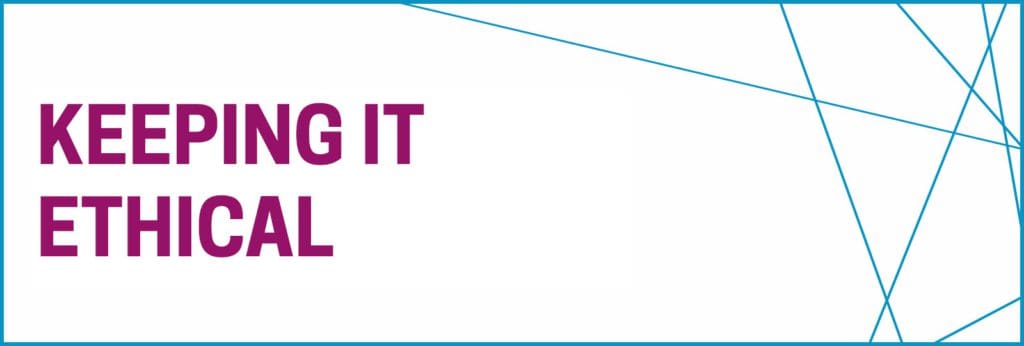Keeping it Ethical is our weekly blog series highlighting the 33 Principles for Good Governance and Ethical Practice. Throughout the series, we hope to highlight the importance of each Principle, the helpful resources associated with it, and learn more from you about how you’ve incorporated these Principles into your charitable organization.
Ethical Emani, our in-house expert on all things Principles and #npethics, has been on the prowl to vanquish moral quandaries by night and squash ethical conflicts by day. Emani returns this week to tackle availability of information to the public.
***
Dear Ethical Emani,
Our nonprofit has a terribly out-of-date website. The lack of recent and easily accessible information reflects poorly on our governance practices and we get emails for information frequently – ones that I must respond to and manage. We received some restricted funding earlier in the year to support a website refresh, but our leadership team has not prioritized the implementation. What should I do to convince leadership that that this is an organizational priority?
Yours truly,
Inquisitive Ingrid
***
Dear Inquisitive Ingrid,
It sounds like you’re sinking a lot of time into tasks that could easily be avoided by a well-organized website. It sounds like they have the funding but not the will to make it happen. So, what can you do to convince them?
Don’t worry, Principle 7 has got you! It is a full-blown arsenal of reasoning and logic on why disclosing information readily is an essential priority for nonprofits. Since charitable organizations serve the public, it’s an ethical imperative to make information about what the heck we’re doing available to said public.
Let the internet do the work by making information easily and widely available. Allowing the public to click around on their own time is key and oozes transparency.
Use the below points and resources to build your transparency rep starting with your website:
Annual Information Returns
Most charitable organizations, with some notable exceptions, are required by law to file an annual information return via the Form 990 series with the IRS. Further, a version of this form needs to be available and accessible widely for public inspection. Simple right?
Well kind of, just be sure you read their hyper detailed rules since there are a bunch of specifics to keep in mind. Specifics like the number of years’ worth of returns that you should make available, whether your application for tax-exempt status needs to be available, and the type of fines that will hit you in the face if you fail to comply.
Annual Reports
A Form 990 can be a boring legal requirement, but an annual report is an implied expectation that you can get excited about! A stellar annual report can generate some serious donor love and be leveraged as a strategic tool for boosting transparency and showcasing impact.
An annual report allows your organization to provide a fuller picture than a dated IRS filing. A decent annual report should note:
- Financials (at minimum, total income, expenditures, and ending net assets and then link over to more detailed information like your audited financial statements)
- Acknowledgement of your board and senior staff (if not all staff), as well as your donors, corporate partners, and program activities
- Your mission, vision, and future direction for the organization
These are just the basics. You should get creative and think about how you can inspire and create a call to action. If your organization doesn’t have an annual report or needs a refresh, do a simple Google search to download templates for nonprofits. Here are some tips from our friends at Classy and Whole Whale.
Website
Annual filings may be compulsory, and an annual report might be a nice tradition, but nothing beats an up-to-date website.
Your website is the primary tool to affirm the importance of transparency and accountability. In fact, most charity watchdogs and review websites like Charity Navigator cull information from your website to report on the accountability and transparency of your institution. Our own Principles also encourage you to include vital board-approved policies related to conflict of interest, whistleblower protection, and travel on the website.
At a minimum, your website should house the above information. Don’t put the public through hoops and searches on other databases to find compulsory information. The easier it is for a person to click and download your Form 990, the better mood they will be in when reviewing it. Of course, every organization has different resources, time, and bandwidth to devote to their website – yes, you should assess needs versus costs, just don’t forget about the hidden costs and money left on the table when choosing to deprioritize technology.
Hopefully, this clear link to accountability and transparency is enough to get your leadership behind creating a current website. If all else fails, maybe send them the latest report on generational giving – 98% of those who give and research a charity before they give count checking that organization’s website as their due diligence.
Crazy! Right? This is just the start – the youths are coming!

This impact to your bottom line should get your leadership excited and help them prioritize getting that new website out into the world. Maybe, just don’t mention social media and mobile giving are also important until this website is done.
Ethically yours,
Emani
___
Learn more about Principle 7 and the associated resources.
Are we missing a great resource associated with this Principle? We want to hear that, too. Leave your thoughts in the comments and let us know what you think. You can also use #npethics on social media.



